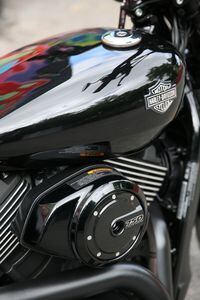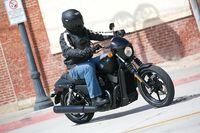For a company accustomed to having pretty much every one of its new designs receive a warm welcome in the showroom, entering the cutthroat world of the entry-level bike is a little like sending a WWE strongman into a, you know, real fistfight. And while you might think Harley-Davidson’s Sportster models are already throwing punches among the machines intended for newbies, truth is they’re only “entry-level” machines because they’re the cheapest, lightest Harleys made.
Hence the new Street models: a 500 and a 750, due here sometime in the second quarter of 2014. What’s the holdup? Priority at the Kansas City plant went to the 500, intended for Harley’s rider-training program. And that’s a hungry mouth, going without a dedicated training mule since 2009 when Buell killed off the Blast. Considering the delay, I was surprised to get an invitation for a brief ride on a pre-production Street 750, held over from a movie premiere. The introduction involved a short photo shoot and two hours of unsupervised riding. More a “first taste” than a road test.
While Harley claims the new Revolution X engine is “inspired by” the Porsche-designed V-Rod engine, in fact it’s a new design that shares mainly the 60-degree V spread. From what I can glean from the specs and drawings, the RevX is a modern, if conservatively designed, engine.
It feels that way, too. Grabbing a little throttle reveals its quick-revving nature, nothing like a Sportster’s lumbering gait. In fact, once I was in the saddle and underway, the Street continued to show how much better a beginner bike it will be than a Sporty. The thin-bladed clutch lever needs little effort, and the short-throw transmission snicks through the gears like—dare I say—a Japanese V-twin. No hammering, no clunking. Torque flows freely at lower revs, but the RevX has good midrange and even a pleasant little surge toward the rev limiter. For the purposes of making new riders comfortable, the Street 750’s engine demeanor hits the bull’s-eye.
But does it feel like a Harley? Not exactly. The 60-degree configuration, integral counterbalancer, and lack of displacement all conspire to make the engine feel different than a familiar H-D mill. It’s busier and less thumpa-thumpa than a Sporty’s engine and only chugs like a Harley right off the bottom. Despite being hard-mounted, vibration is well controlled.
Probably because of its relatively light weight (489 pounds claimed curb weight, 73 less than an 883 Iron) and supposedly “long travel” suspension, the Street 750 rolls over pavement lumps that would have an Iron rider hovering over the saddle. When the road gets really bumpy, the cut-rate nature of the suspension reveals itself, but overall the ride is smooth, predictable, and well balanced. For an entry-level cruiser, the Street has a generous amount of cornering clearance.
Now the difficult discussion: fit and finish. I should cut Harley a little slack for the fact that the two machines I sampled were hand-built at the Product Development Center in Milwaukee. They may or may not have final-spec pieces. They may or may not represent what Harley can do on actual customer machines. But the Street, as presented, was not impressive. Stand around the machine and soon you’re seeing sloppy welds, unfinished-looking wiring, rough castings, panel gaps, cheap and unfinished switchgear, and other transgressions—one of the most noticeable is the poor fit of the exhaust heat shield where it meets the muffler.
Some explanation for the low-end parts begins with the low-end sticker. Harley will ask just $6,599 for the Street 500 and $7,499 for the 750. (Aside from displacement, the two will be identical.) I’m eager to see how the actual production Streets look, but Harley needs to raise its game on fit and finish. That bar and shield on the tank carries raised expectations, you know.













/cloudfront-us-east-1.images.arcpublishing.com/octane/TNOU5DNE2BC57MFPMGN2EIDXAM.jpg)
/cloudfront-us-east-1.images.arcpublishing.com/octane/GTCXACQGJ5HAPDTGWUQKDEH44E.jpg)
/cloudfront-us-east-1.images.arcpublishing.com/octane/S35YGSEMEZB4BLTDJTSZPF4GLA.jpg)
/cloudfront-us-east-1.images.arcpublishing.com/octane/5UOT6HPX2JFMRJAX6EH45AR4MQ.jpg)
/cloudfront-us-east-1.images.arcpublishing.com/octane/OKWOJWAKP5EP3OACCRRWPCIX2Q.jpg)
/cloudfront-us-east-1.images.arcpublishing.com/octane/2WF3SCE3NFBQXLDNJM7KMXA45E.jpg)
/cloudfront-us-east-1.images.arcpublishing.com/octane/G4MG6OUCJNBSHIS2MVVOTPX65E.jpg)
/cloudfront-us-east-1.images.arcpublishing.com/octane/IIGGWFOTOJGB7DB6DGBXCCMTDY.jpg)
/cloudfront-us-east-1.images.arcpublishing.com/octane/QSTCM6AVEZA5JJBUXNIQ3DSOF4.jpg)
/cloudfront-us-east-1.images.arcpublishing.com/octane/U4I7G625B5DMLF2DVIJDFZVV6M.jpg)
/cloudfront-us-east-1.images.arcpublishing.com/octane/B6XD6LS6IVCQPIU6HXDJSM3FHY.jpg)
/cloudfront-us-east-1.images.arcpublishing.com/octane/ICL63FEDDRDTTMINYICCEYGMDA.jpg)
/cloudfront-us-east-1.images.arcpublishing.com/octane/FCGZHQXRBZFLBAPC5SDIQLVF4I.jpg)
/cloudfront-us-east-1.images.arcpublishing.com/octane/WNOB6LDOIFFHJKPSVIWDYUGOPM.jpg)

/cloudfront-us-east-1.images.arcpublishing.com/octane/X33NU3E525ECRHXLNUJN2FTRKI.jpg)
/cloudfront-us-east-1.images.arcpublishing.com/octane/6KKT5NNL2JAVBOXMZYS5ZO76YA.jpg)
/cloudfront-us-east-1.images.arcpublishing.com/octane/J5RKG5O455GMPGQRF2OG6LRT7A.jpg)
/cloudfront-us-east-1.images.arcpublishing.com/octane/GX2CIZKQVRH2TATDM26KFG2DAE.jpg)
/cloudfront-us-east-1.images.arcpublishing.com/octane/ZWIDYSAKQZHD5BHREMQILXJCGM.jpg)
/cloudfront-us-east-1.images.arcpublishing.com/octane/CYUHJZCTSJCH3MRAQEIKXK7SCQ.jpg)
/cloudfront-us-east-1.images.arcpublishing.com/octane/LKOFINY56FCXJCANJ5M7ZDQUBY.jpg)
/cloudfront-us-east-1.images.arcpublishing.com/octane/4NBPDACMWJH63JQYJVK3QRBDZI.jpg)
/cloudfront-us-east-1.images.arcpublishing.com/octane/KKHQHRR3FJGX7H2IPU6RALMWG4.jpg)